Quantitative Research Methods: Design, Analysis, and Limitations
VerifiedAdded on 2022/09/29
|9
|2358
|17
Report
AI Summary
This report provides a comprehensive overview of quantitative research methods, beginning with an introduction to the concept and its applications. It explores various aspects of quantitative research design, emphasizing the collection of quantifiable data through surveys, questionnaires, and other methods. The report delves into the theoretical assumptions underlying quantitative research, highlighting its objective nature and reliance on deductive logic. It addresses common research questions and details different approaches to data collection and analysis, including the use of statistical techniques and the identification of variables. The report also covers sampling methods, forms of reporting, and the aims of quantitative research, such as understanding social phenomena and generalizing findings. It concludes with a discussion of the strengths and limitations of quantitative research, including its ability to generalize findings and its challenges in understanding context and managing large sample sizes, and control for the research environment. The report references several sources and presents information in an accessible manner.
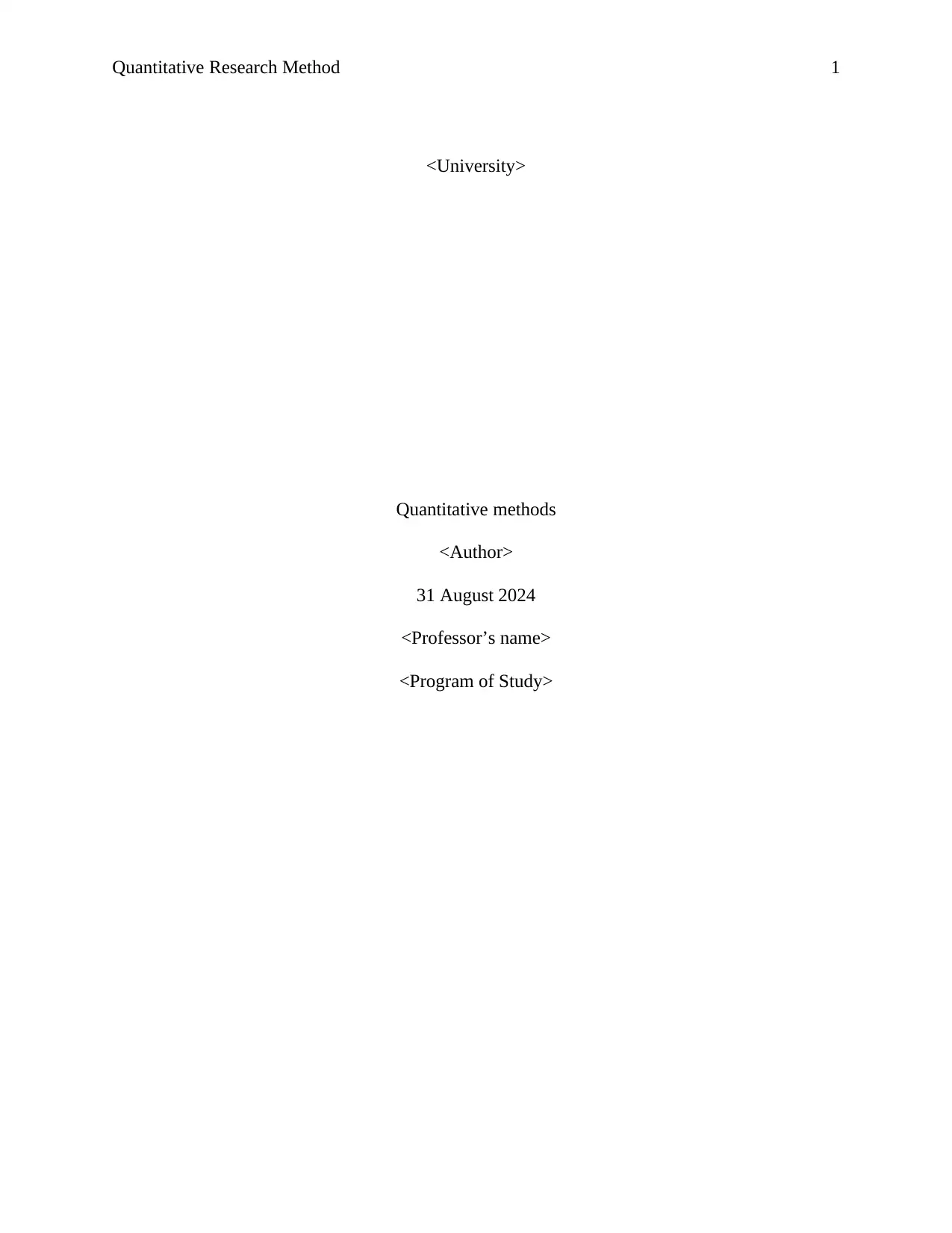
Quantitative Research Method 1
<University>
Quantitative methods
<Author>
31 August 2024
<Professor’s name>
<Program of Study>
<University>
Quantitative methods
<Author>
31 August 2024
<Professor’s name>
<Program of Study>
Paraphrase This Document
Need a fresh take? Get an instant paraphrase of this document with our AI Paraphraser
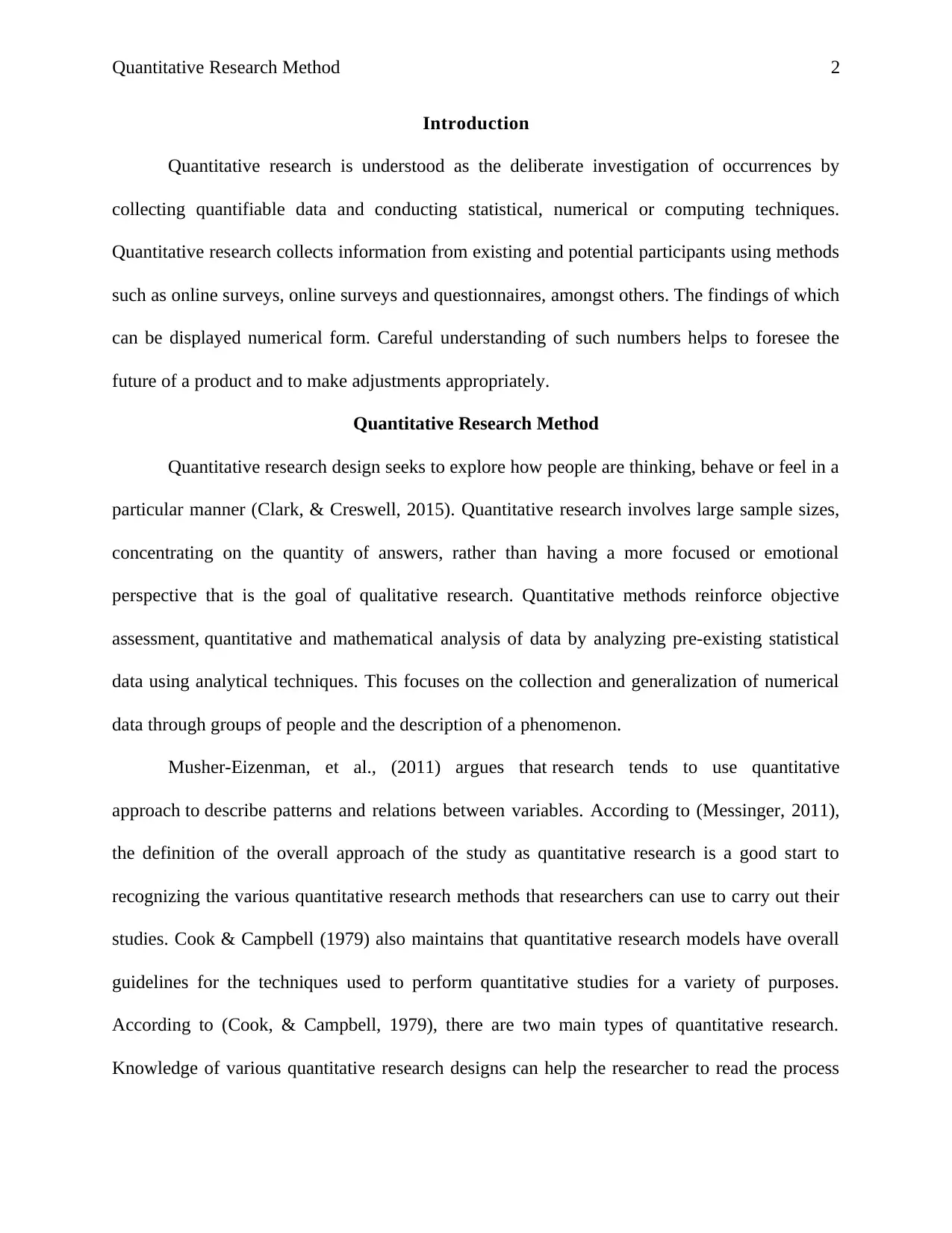
Quantitative Research Method 2
Introduction
Quantitative research is understood as the deliberate investigation of occurrences by
collecting quantifiable data and conducting statistical, numerical or computing techniques.
Quantitative research collects information from existing and potential participants using methods
such as online surveys, online surveys and questionnaires, amongst others. The findings of which
can be displayed numerical form. Careful understanding of such numbers helps to foresee the
future of a product and to make adjustments appropriately.
Quantitative Research Method
Quantitative research design seeks to explore how people are thinking, behave or feel in a
particular manner (Clark, & Creswell, 2015). Quantitative research involves large sample sizes,
concentrating on the quantity of answers, rather than having a more focused or emotional
perspective that is the goal of qualitative research. Quantitative methods reinforce objective
assessment, quantitative and mathematical analysis of data by analyzing pre-existing statistical
data using analytical techniques. This focuses on the collection and generalization of numerical
data through groups of people and the description of a phenomenon.
Musher-Eizenman, et al., (2011) argues that research tends to use quantitative
approach to describe patterns and relations between variables. According to (Messinger, 2011),
the definition of the overall approach of the study as quantitative research is a good start to
recognizing the various quantitative research methods that researchers can use to carry out their
studies. Cook & Campbell (1979) also maintains that quantitative research models have overall
guidelines for the techniques used to perform quantitative studies for a variety of purposes.
According to (Cook, & Campbell, 1979), there are two main types of quantitative research.
Knowledge of various quantitative research designs can help the researcher to read the process
Introduction
Quantitative research is understood as the deliberate investigation of occurrences by
collecting quantifiable data and conducting statistical, numerical or computing techniques.
Quantitative research collects information from existing and potential participants using methods
such as online surveys, online surveys and questionnaires, amongst others. The findings of which
can be displayed numerical form. Careful understanding of such numbers helps to foresee the
future of a product and to make adjustments appropriately.
Quantitative Research Method
Quantitative research design seeks to explore how people are thinking, behave or feel in a
particular manner (Clark, & Creswell, 2015). Quantitative research involves large sample sizes,
concentrating on the quantity of answers, rather than having a more focused or emotional
perspective that is the goal of qualitative research. Quantitative methods reinforce objective
assessment, quantitative and mathematical analysis of data by analyzing pre-existing statistical
data using analytical techniques. This focuses on the collection and generalization of numerical
data through groups of people and the description of a phenomenon.
Musher-Eizenman, et al., (2011) argues that research tends to use quantitative
approach to describe patterns and relations between variables. According to (Messinger, 2011),
the definition of the overall approach of the study as quantitative research is a good start to
recognizing the various quantitative research methods that researchers can use to carry out their
studies. Cook & Campbell (1979) also maintains that quantitative research models have overall
guidelines for the techniques used to perform quantitative studies for a variety of purposes.
According to (Cook, & Campbell, 1979), there are two main types of quantitative research.
Knowledge of various quantitative research designs can help the researcher to read the process
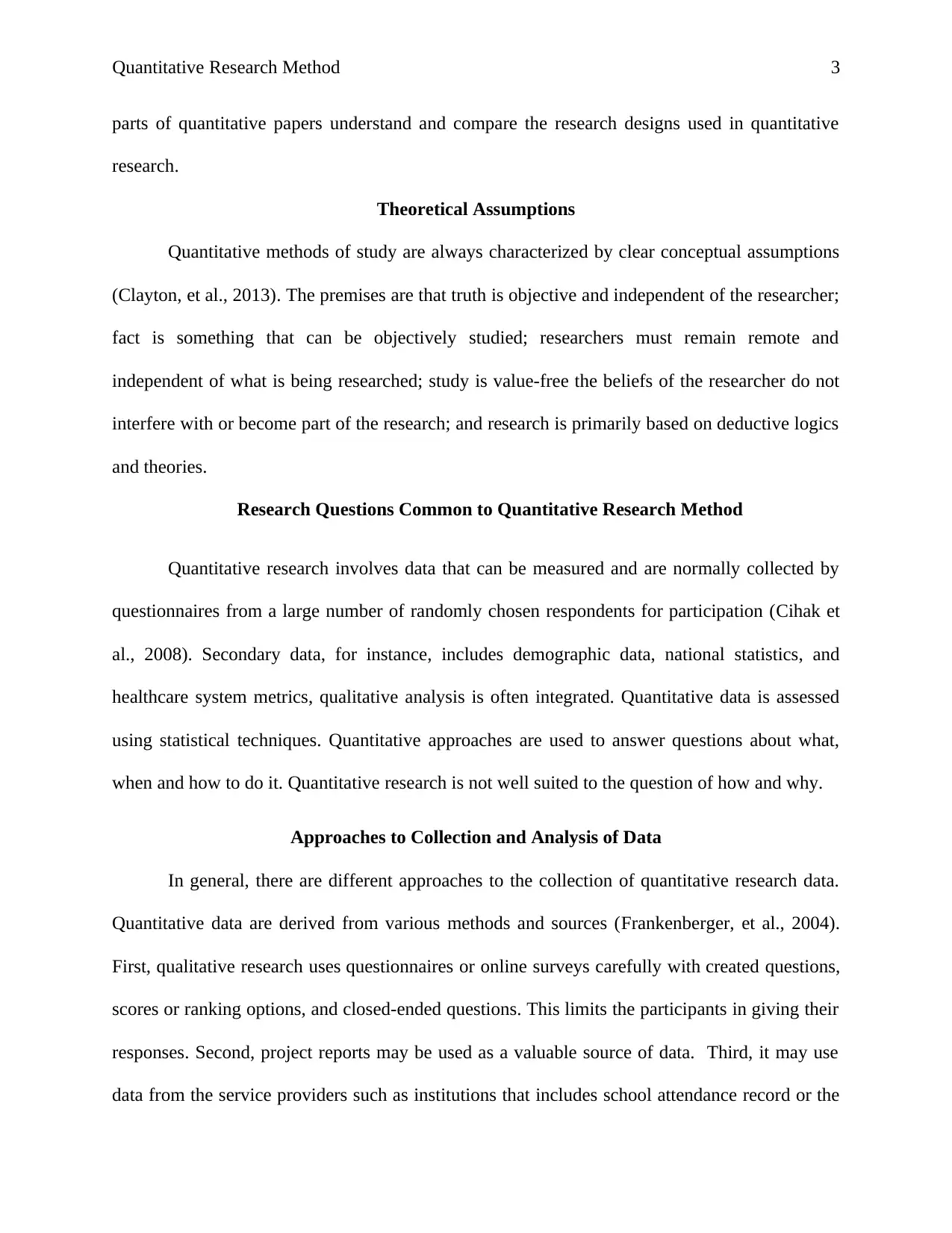
Quantitative Research Method 3
parts of quantitative papers understand and compare the research designs used in quantitative
research.
Theoretical Assumptions
Quantitative methods of study are always characterized by clear conceptual assumptions
(Clayton, et al., 2013). The premises are that truth is objective and independent of the researcher;
fact is something that can be objectively studied; researchers must remain remote and
independent of what is being researched; study is value-free the beliefs of the researcher do not
interfere with or become part of the research; and research is primarily based on deductive logics
and theories.
Research Questions Common to Quantitative Research Method
Quantitative research involves data that can be measured and are normally collected by
questionnaires from a large number of randomly chosen respondents for participation (Cihak et
al., 2008). Secondary data, for instance, includes demographic data, national statistics, and
healthcare system metrics, qualitative analysis is often integrated. Quantitative data is assessed
using statistical techniques. Quantitative approaches are used to answer questions about what,
when and how to do it. Quantitative research is not well suited to the question of how and why.
Approaches to Collection and Analysis of Data
In general, there are different approaches to the collection of quantitative research data.
Quantitative data are derived from various methods and sources (Frankenberger, et al., 2004).
First, qualitative research uses questionnaires or online surveys carefully with created questions,
scores or ranking options, and closed-ended questions. This limits the participants in giving their
responses. Second, project reports may be used as a valuable source of data. Third, it may use
data from the service providers such as institutions that includes school attendance record or the
parts of quantitative papers understand and compare the research designs used in quantitative
research.
Theoretical Assumptions
Quantitative methods of study are always characterized by clear conceptual assumptions
(Clayton, et al., 2013). The premises are that truth is objective and independent of the researcher;
fact is something that can be objectively studied; researchers must remain remote and
independent of what is being researched; study is value-free the beliefs of the researcher do not
interfere with or become part of the research; and research is primarily based on deductive logics
and theories.
Research Questions Common to Quantitative Research Method
Quantitative research involves data that can be measured and are normally collected by
questionnaires from a large number of randomly chosen respondents for participation (Cihak et
al., 2008). Secondary data, for instance, includes demographic data, national statistics, and
healthcare system metrics, qualitative analysis is often integrated. Quantitative data is assessed
using statistical techniques. Quantitative approaches are used to answer questions about what,
when and how to do it. Quantitative research is not well suited to the question of how and why.
Approaches to Collection and Analysis of Data
In general, there are different approaches to the collection of quantitative research data.
Quantitative data are derived from various methods and sources (Frankenberger, et al., 2004).
First, qualitative research uses questionnaires or online surveys carefully with created questions,
scores or ranking options, and closed-ended questions. This limits the participants in giving their
responses. Second, project reports may be used as a valuable source of data. Third, it may use
data from the service providers such as institutions that includes school attendance record or the
⊘ This is a preview!⊘
Do you want full access?
Subscribe today to unlock all pages.

Trusted by 1+ million students worldwide
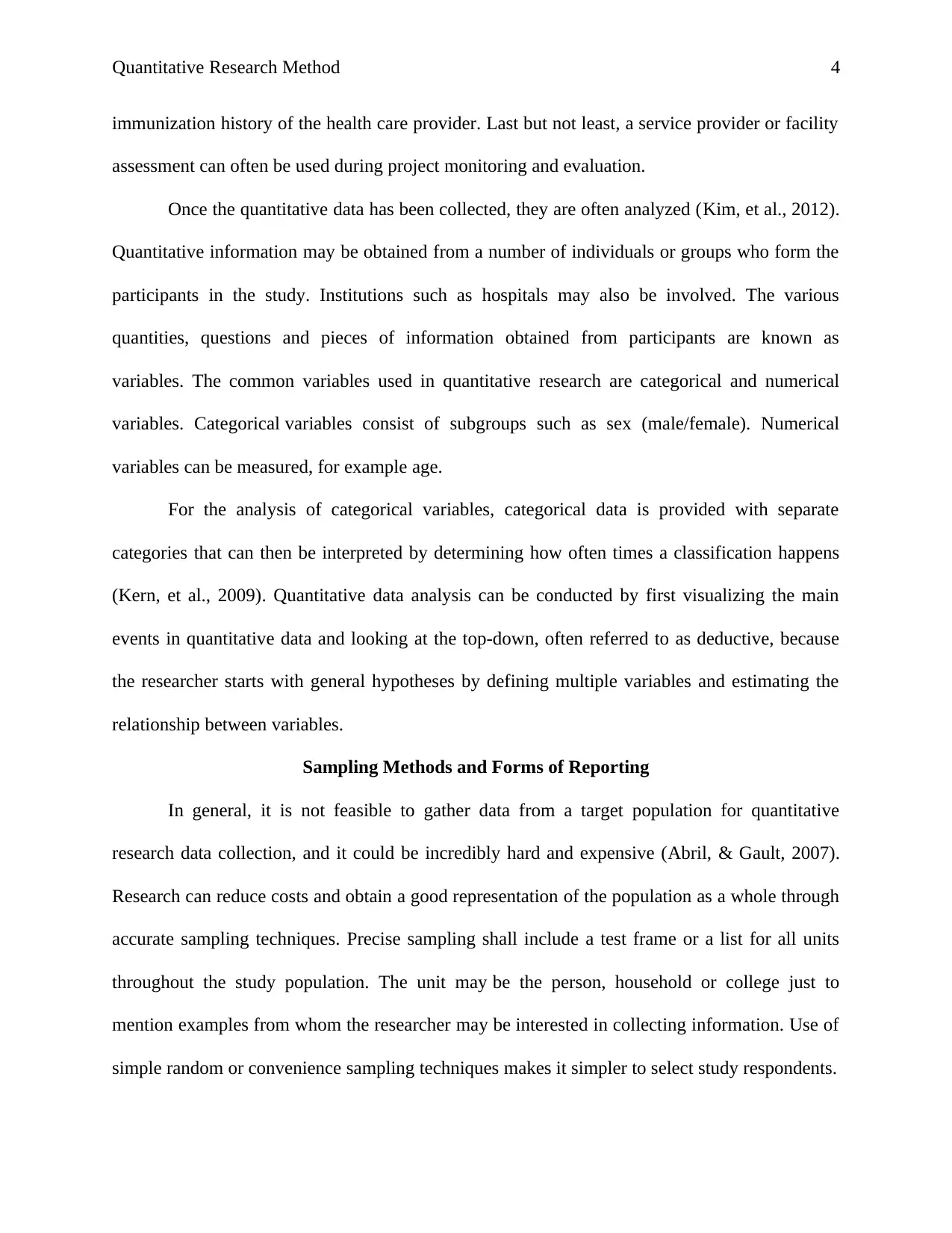
Quantitative Research Method 4
immunization history of the health care provider. Last but not least, a service provider or facility
assessment can often be used during project monitoring and evaluation.
Once the quantitative data has been collected, they are often analyzed (Kim, et al., 2012).
Quantitative information may be obtained from a number of individuals or groups who form the
participants in the study. Institutions such as hospitals may also be involved. The various
quantities, questions and pieces of information obtained from participants are known as
variables. The common variables used in quantitative research are categorical and numerical
variables. Categorical variables consist of subgroups such as sex (male/female). Numerical
variables can be measured, for example age.
For the analysis of categorical variables, categorical data is provided with separate
categories that can then be interpreted by determining how often times a classification happens
(Kern, et al., 2009). Quantitative data analysis can be conducted by first visualizing the main
events in quantitative data and looking at the top-down, often referred to as deductive, because
the researcher starts with general hypotheses by defining multiple variables and estimating the
relationship between variables.
Sampling Methods and Forms of Reporting
In general, it is not feasible to gather data from a target population for quantitative
research data collection, and it could be incredibly hard and expensive (Abril, & Gault, 2007).
Research can reduce costs and obtain a good representation of the population as a whole through
accurate sampling techniques. Precise sampling shall include a test frame or a list for all units
throughout the study population. The unit may be the person, household or college just to
mention examples from whom the researcher may be interested in collecting information. Use of
simple random or convenience sampling techniques makes it simpler to select study respondents.
immunization history of the health care provider. Last but not least, a service provider or facility
assessment can often be used during project monitoring and evaluation.
Once the quantitative data has been collected, they are often analyzed (Kim, et al., 2012).
Quantitative information may be obtained from a number of individuals or groups who form the
participants in the study. Institutions such as hospitals may also be involved. The various
quantities, questions and pieces of information obtained from participants are known as
variables. The common variables used in quantitative research are categorical and numerical
variables. Categorical variables consist of subgroups such as sex (male/female). Numerical
variables can be measured, for example age.
For the analysis of categorical variables, categorical data is provided with separate
categories that can then be interpreted by determining how often times a classification happens
(Kern, et al., 2009). Quantitative data analysis can be conducted by first visualizing the main
events in quantitative data and looking at the top-down, often referred to as deductive, because
the researcher starts with general hypotheses by defining multiple variables and estimating the
relationship between variables.
Sampling Methods and Forms of Reporting
In general, it is not feasible to gather data from a target population for quantitative
research data collection, and it could be incredibly hard and expensive (Abril, & Gault, 2007).
Research can reduce costs and obtain a good representation of the population as a whole through
accurate sampling techniques. Precise sampling shall include a test frame or a list for all units
throughout the study population. The unit may be the person, household or college just to
mention examples from whom the researcher may be interested in collecting information. Use of
simple random or convenience sampling techniques makes it simpler to select study respondents.
Paraphrase This Document
Need a fresh take? Get an instant paraphrase of this document with our AI Paraphraser
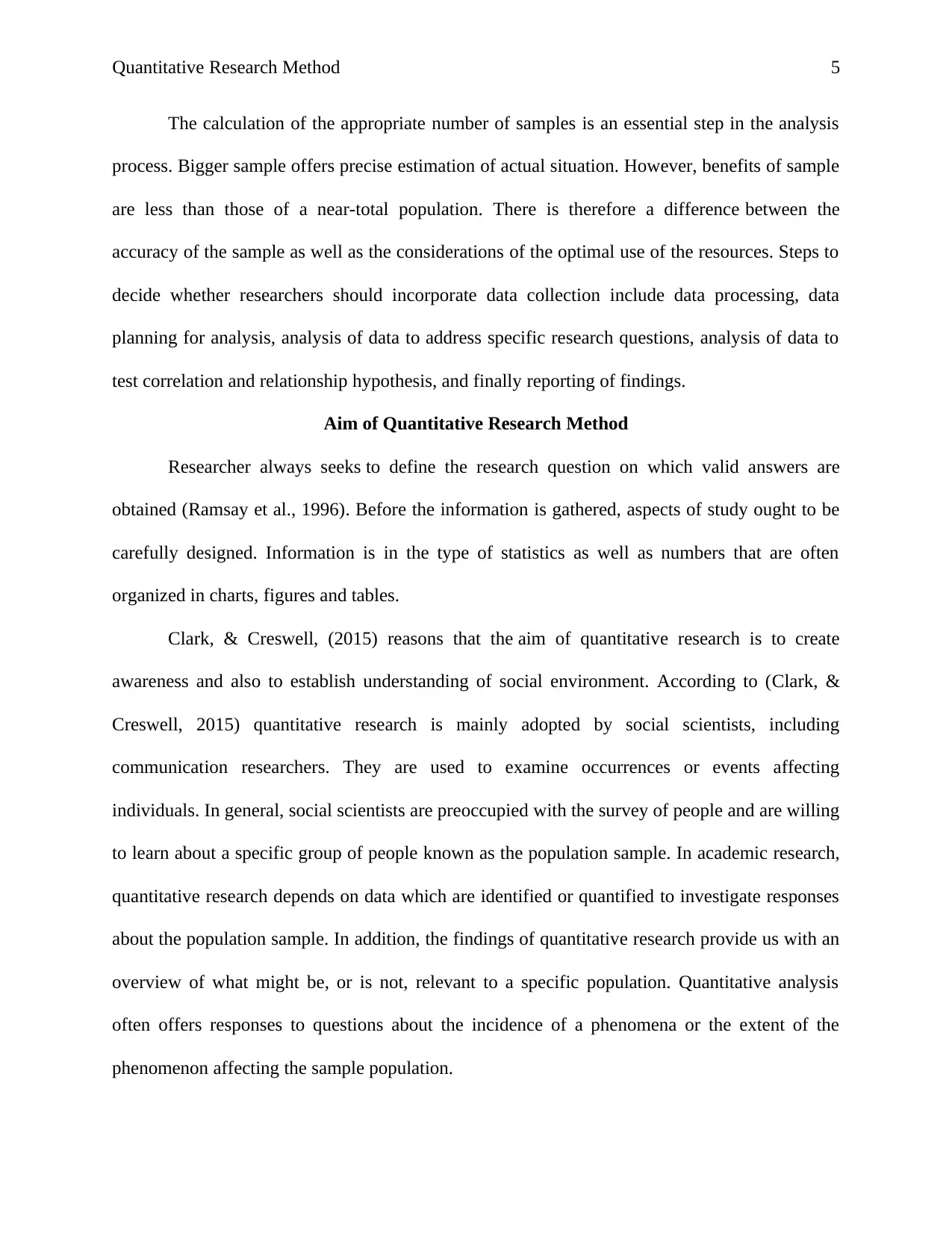
Quantitative Research Method 5
The calculation of the appropriate number of samples is an essential step in the analysis
process. Bigger sample offers precise estimation of actual situation. However, benefits of sample
are less than those of a near-total population. There is therefore a difference between the
accuracy of the sample as well as the considerations of the optimal use of the resources. Steps to
decide whether researchers should incorporate data collection include data processing, data
planning for analysis, analysis of data to address specific research questions, analysis of data to
test correlation and relationship hypothesis, and finally reporting of findings.
Aim of Quantitative Research Method
Researcher always seeks to define the research question on which valid answers are
obtained (Ramsay et al., 1996). Before the information is gathered, aspects of study ought to be
carefully designed. Information is in the type of statistics as well as numbers that are often
organized in charts, figures and tables.
Clark, & Creswell, (2015) reasons that the aim of quantitative research is to create
awareness and also to establish understanding of social environment. According to (Clark, &
Creswell, 2015) quantitative research is mainly adopted by social scientists, including
communication researchers. They are used to examine occurrences or events affecting
individuals. In general, social scientists are preoccupied with the survey of people and are willing
to learn about a specific group of people known as the population sample. In academic research,
quantitative research depends on data which are identified or quantified to investigate responses
about the population sample. In addition, the findings of quantitative research provide us with an
overview of what might be, or is not, relevant to a specific population. Quantitative analysis
often offers responses to questions about the incidence of a phenomena or the extent of the
phenomenon affecting the sample population.
The calculation of the appropriate number of samples is an essential step in the analysis
process. Bigger sample offers precise estimation of actual situation. However, benefits of sample
are less than those of a near-total population. There is therefore a difference between the
accuracy of the sample as well as the considerations of the optimal use of the resources. Steps to
decide whether researchers should incorporate data collection include data processing, data
planning for analysis, analysis of data to address specific research questions, analysis of data to
test correlation and relationship hypothesis, and finally reporting of findings.
Aim of Quantitative Research Method
Researcher always seeks to define the research question on which valid answers are
obtained (Ramsay et al., 1996). Before the information is gathered, aspects of study ought to be
carefully designed. Information is in the type of statistics as well as numbers that are often
organized in charts, figures and tables.
Clark, & Creswell, (2015) reasons that the aim of quantitative research is to create
awareness and also to establish understanding of social environment. According to (Clark, &
Creswell, 2015) quantitative research is mainly adopted by social scientists, including
communication researchers. They are used to examine occurrences or events affecting
individuals. In general, social scientists are preoccupied with the survey of people and are willing
to learn about a specific group of people known as the population sample. In academic research,
quantitative research depends on data which are identified or quantified to investigate responses
about the population sample. In addition, the findings of quantitative research provide us with an
overview of what might be, or is not, relevant to a specific population. Quantitative analysis
often offers responses to questions about the incidence of a phenomena or the extent of the
phenomenon affecting the sample population.
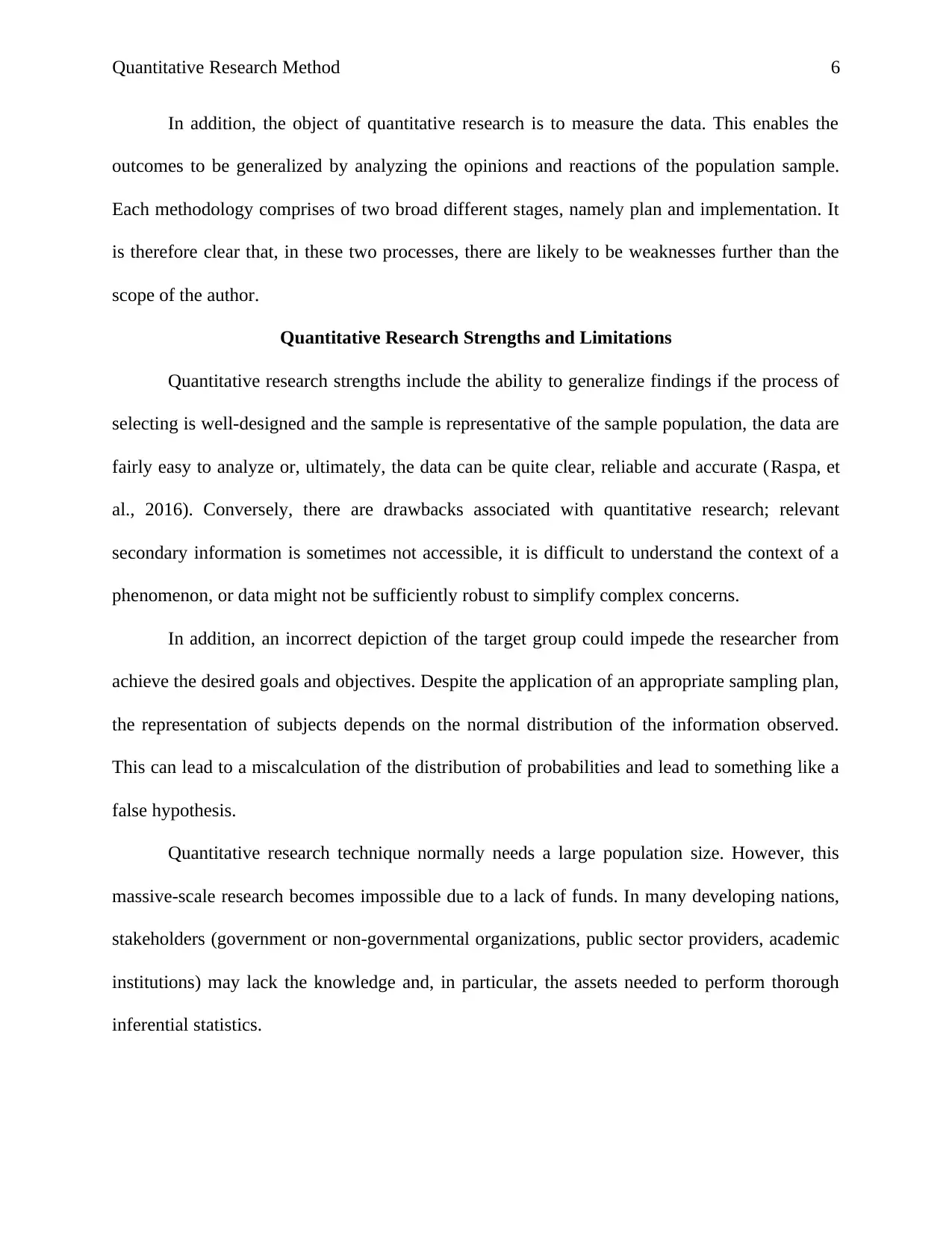
Quantitative Research Method 6
In addition, the object of quantitative research is to measure the data. This enables the
outcomes to be generalized by analyzing the opinions and reactions of the population sample.
Each methodology comprises of two broad different stages, namely plan and implementation. It
is therefore clear that, in these two processes, there are likely to be weaknesses further than the
scope of the author.
Quantitative Research Strengths and Limitations
Quantitative research strengths include the ability to generalize findings if the process of
selecting is well-designed and the sample is representative of the sample population, the data are
fairly easy to analyze or, ultimately, the data can be quite clear, reliable and accurate (Raspa, et
al., 2016). Conversely, there are drawbacks associated with quantitative research; relevant
secondary information is sometimes not accessible, it is difficult to understand the context of a
phenomenon, or data might not be sufficiently robust to simplify complex concerns.
In addition, an incorrect depiction of the target group could impede the researcher from
achieve the desired goals and objectives. Despite the application of an appropriate sampling plan,
the representation of subjects depends on the normal distribution of the information observed.
This can lead to a miscalculation of the distribution of probabilities and lead to something like a
false hypothesis.
Quantitative research technique normally needs a large population size. However, this
massive-scale research becomes impossible due to a lack of funds. In many developing nations,
stakeholders (government or non-governmental organizations, public sector providers, academic
institutions) may lack the knowledge and, in particular, the assets needed to perform thorough
inferential statistics.
In addition, the object of quantitative research is to measure the data. This enables the
outcomes to be generalized by analyzing the opinions and reactions of the population sample.
Each methodology comprises of two broad different stages, namely plan and implementation. It
is therefore clear that, in these two processes, there are likely to be weaknesses further than the
scope of the author.
Quantitative Research Strengths and Limitations
Quantitative research strengths include the ability to generalize findings if the process of
selecting is well-designed and the sample is representative of the sample population, the data are
fairly easy to analyze or, ultimately, the data can be quite clear, reliable and accurate (Raspa, et
al., 2016). Conversely, there are drawbacks associated with quantitative research; relevant
secondary information is sometimes not accessible, it is difficult to understand the context of a
phenomenon, or data might not be sufficiently robust to simplify complex concerns.
In addition, an incorrect depiction of the target group could impede the researcher from
achieve the desired goals and objectives. Despite the application of an appropriate sampling plan,
the representation of subjects depends on the normal distribution of the information observed.
This can lead to a miscalculation of the distribution of probabilities and lead to something like a
false hypothesis.
Quantitative research technique normally needs a large population size. However, this
massive-scale research becomes impossible due to a lack of funds. In many developing nations,
stakeholders (government or non-governmental organizations, public sector providers, academic
institutions) may lack the knowledge and, in particular, the assets needed to perform thorough
inferential statistics.
⊘ This is a preview!⊘
Do you want full access?
Subscribe today to unlock all pages.

Trusted by 1+ million students worldwide
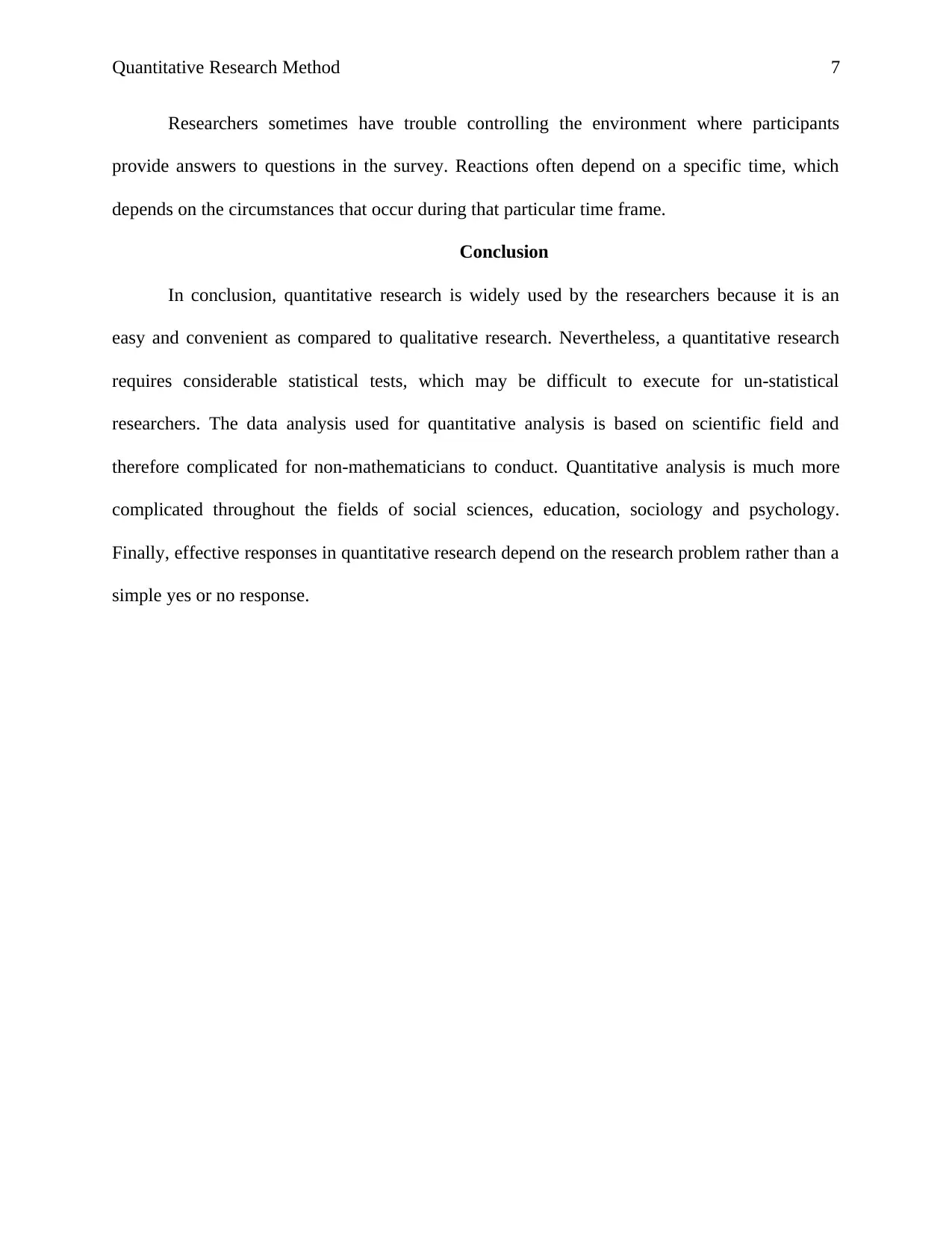
Quantitative Research Method 7
Researchers sometimes have trouble controlling the environment where participants
provide answers to questions in the survey. Reactions often depend on a specific time, which
depends on the circumstances that occur during that particular time frame.
Conclusion
In conclusion, quantitative research is widely used by the researchers because it is an
easy and convenient as compared to qualitative research. Nevertheless, a quantitative research
requires considerable statistical tests, which may be difficult to execute for un-statistical
researchers. The data analysis used for quantitative analysis is based on scientific field and
therefore complicated for non-mathematicians to conduct. Quantitative analysis is much more
complicated throughout the fields of social sciences, education, sociology and psychology.
Finally, effective responses in quantitative research depend on the research problem rather than a
simple yes or no response.
Researchers sometimes have trouble controlling the environment where participants
provide answers to questions in the survey. Reactions often depend on a specific time, which
depends on the circumstances that occur during that particular time frame.
Conclusion
In conclusion, quantitative research is widely used by the researchers because it is an
easy and convenient as compared to qualitative research. Nevertheless, a quantitative research
requires considerable statistical tests, which may be difficult to execute for un-statistical
researchers. The data analysis used for quantitative analysis is based on scientific field and
therefore complicated for non-mathematicians to conduct. Quantitative analysis is much more
complicated throughout the fields of social sciences, education, sociology and psychology.
Finally, effective responses in quantitative research depend on the research problem rather than a
simple yes or no response.
Paraphrase This Document
Need a fresh take? Get an instant paraphrase of this document with our AI Paraphraser
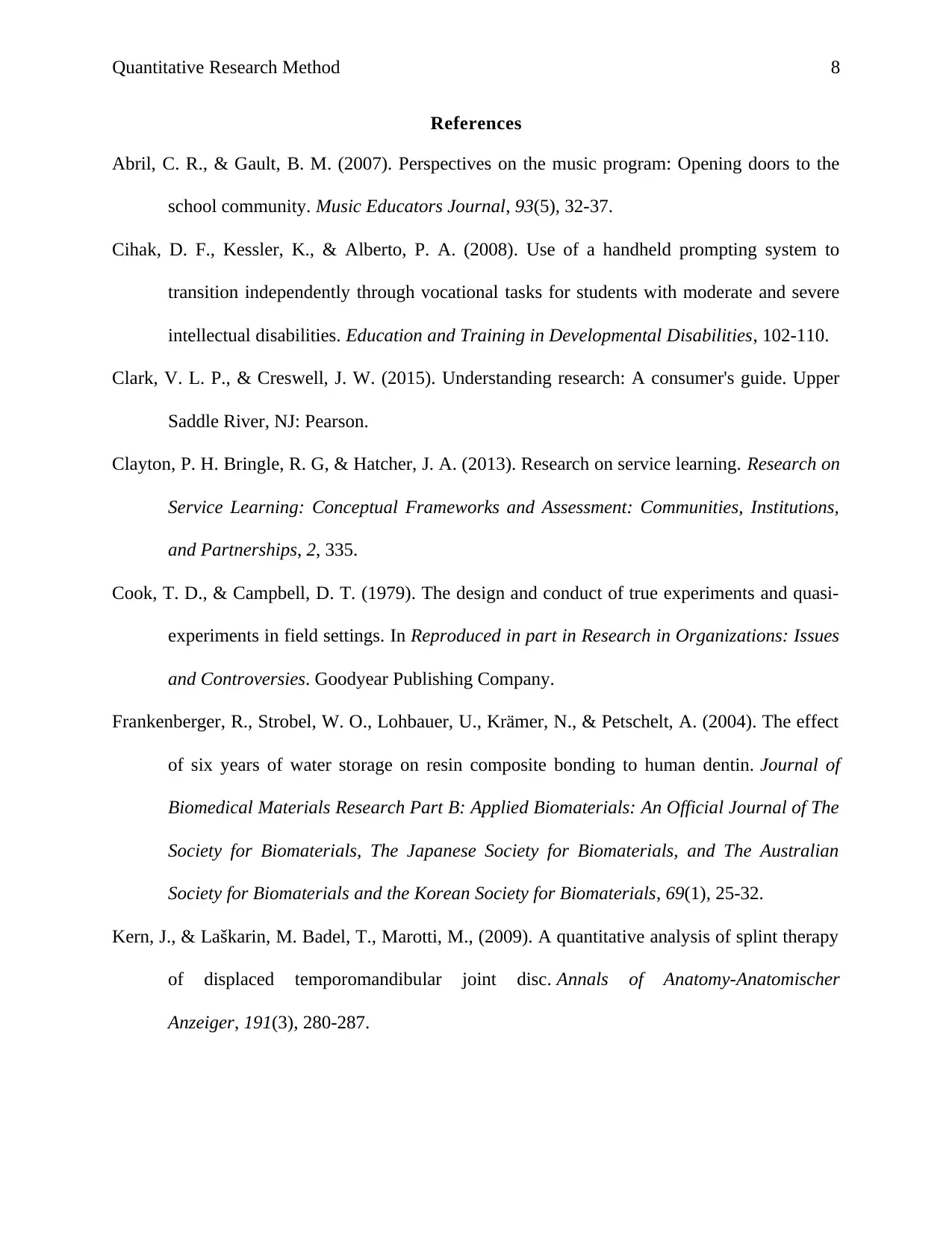
Quantitative Research Method 8
References
Abril, C. R., & Gault, B. M. (2007). Perspectives on the music program: Opening doors to the
school community. Music Educators Journal, 93(5), 32-37.
Cihak, D. F., Kessler, K., & Alberto, P. A. (2008). Use of a handheld prompting system to
transition independently through vocational tasks for students with moderate and severe
intellectual disabilities. Education and Training in Developmental Disabilities, 102-110.
Clark, V. L. P., & Creswell, J. W. (2015). Understanding research: A consumer's guide. Upper
Saddle River, NJ: Pearson.
Clayton, P. H. Bringle, R. G, & Hatcher, J. A. (2013). Research on service learning. Research on
Service Learning: Conceptual Frameworks and Assessment: Communities, Institutions,
and Partnerships, 2, 335.
Cook, T. D., & Campbell, D. T. (1979). The design and conduct of true experiments and quasi-
experiments in field settings. In Reproduced in part in Research in Organizations: Issues
and Controversies. Goodyear Publishing Company.
Frankenberger, R., Strobel, W. O., Lohbauer, U., Krämer, N., & Petschelt, A. (2004). The effect
of six years of water storage on resin composite bonding to human dentin. Journal of
Biomedical Materials Research Part B: Applied Biomaterials: An Official Journal of The
Society for Biomaterials, The Japanese Society for Biomaterials, and The Australian
Society for Biomaterials and the Korean Society for Biomaterials, 69(1), 25-32.
Kern, J., & Laškarin, M. Badel, T., Marotti, M., (2009). A quantitative analysis of splint therapy
of displaced temporomandibular joint disc. Annals of Anatomy-Anatomischer
Anzeiger, 191(3), 280-287.
References
Abril, C. R., & Gault, B. M. (2007). Perspectives on the music program: Opening doors to the
school community. Music Educators Journal, 93(5), 32-37.
Cihak, D. F., Kessler, K., & Alberto, P. A. (2008). Use of a handheld prompting system to
transition independently through vocational tasks for students with moderate and severe
intellectual disabilities. Education and Training in Developmental Disabilities, 102-110.
Clark, V. L. P., & Creswell, J. W. (2015). Understanding research: A consumer's guide. Upper
Saddle River, NJ: Pearson.
Clayton, P. H. Bringle, R. G, & Hatcher, J. A. (2013). Research on service learning. Research on
Service Learning: Conceptual Frameworks and Assessment: Communities, Institutions,
and Partnerships, 2, 335.
Cook, T. D., & Campbell, D. T. (1979). The design and conduct of true experiments and quasi-
experiments in field settings. In Reproduced in part in Research in Organizations: Issues
and Controversies. Goodyear Publishing Company.
Frankenberger, R., Strobel, W. O., Lohbauer, U., Krämer, N., & Petschelt, A. (2004). The effect
of six years of water storage on resin composite bonding to human dentin. Journal of
Biomedical Materials Research Part B: Applied Biomaterials: An Official Journal of The
Society for Biomaterials, The Japanese Society for Biomaterials, and The Australian
Society for Biomaterials and the Korean Society for Biomaterials, 69(1), 25-32.
Kern, J., & Laškarin, M. Badel, T., Marotti, M., (2009). A quantitative analysis of splint therapy
of displaced temporomandibular joint disc. Annals of Anatomy-Anatomischer
Anzeiger, 191(3), 280-287.
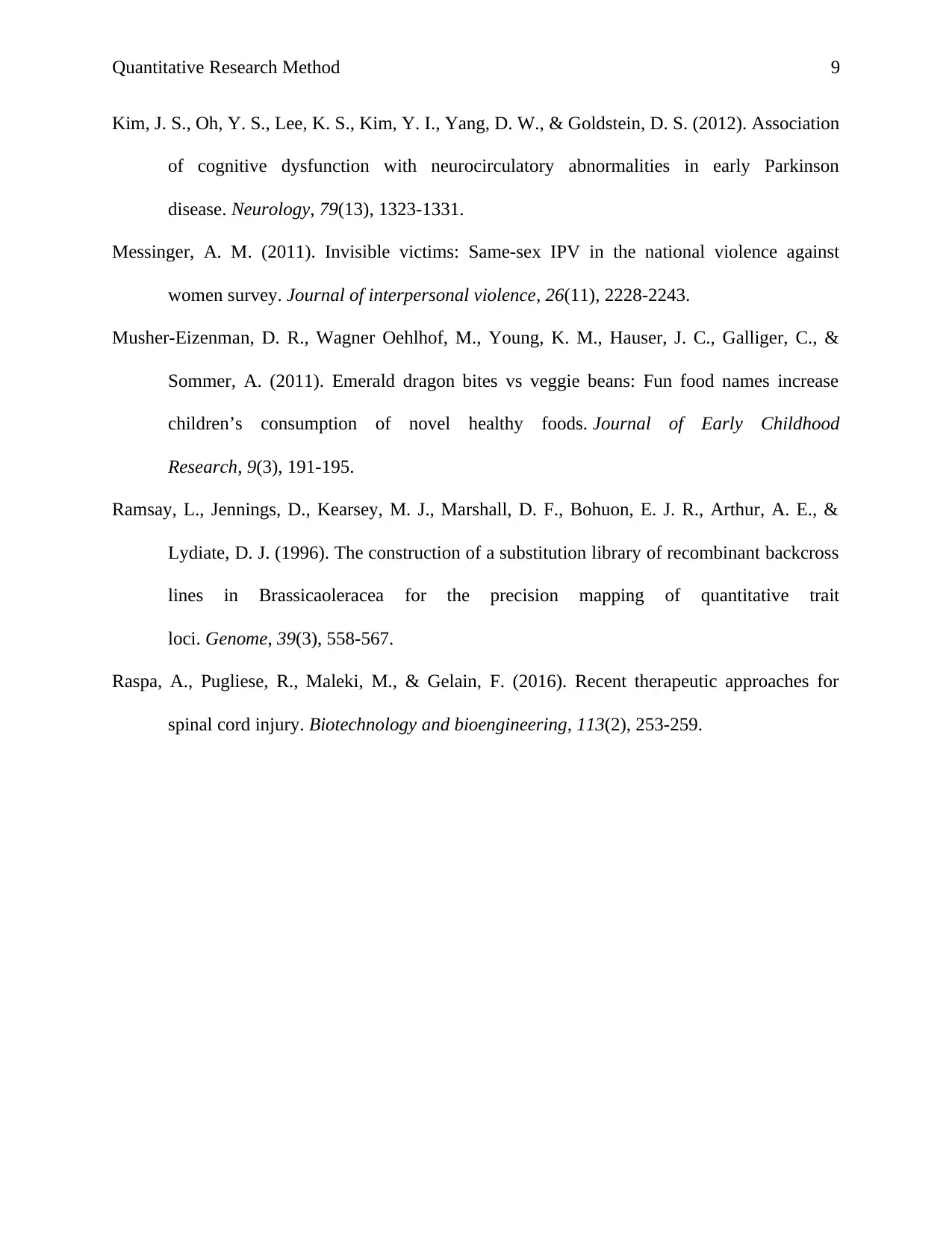
Quantitative Research Method 9
Kim, J. S., Oh, Y. S., Lee, K. S., Kim, Y. I., Yang, D. W., & Goldstein, D. S. (2012). Association
of cognitive dysfunction with neurocirculatory abnormalities in early Parkinson
disease. Neurology, 79(13), 1323-1331.
Messinger, A. M. (2011). Invisible victims: Same-sex IPV in the national violence against
women survey. Journal of interpersonal violence, 26(11), 2228-2243.
Musher-Eizenman, D. R., Wagner Oehlhof, M., Young, K. M., Hauser, J. C., Galliger, C., &
Sommer, A. (2011). Emerald dragon bites vs veggie beans: Fun food names increase
children’s consumption of novel healthy foods. Journal of Early Childhood
Research, 9(3), 191-195.
Ramsay, L., Jennings, D., Kearsey, M. J., Marshall, D. F., Bohuon, E. J. R., Arthur, A. E., &
Lydiate, D. J. (1996). The construction of a substitution library of recombinant backcross
lines in Brassicaoleracea for the precision mapping of quantitative trait
loci. Genome, 39(3), 558-567.
Raspa, A., Pugliese, R., Maleki, M., & Gelain, F. (2016). Recent therapeutic approaches for
spinal cord injury. Biotechnology and bioengineering, 113(2), 253-259.
Kim, J. S., Oh, Y. S., Lee, K. S., Kim, Y. I., Yang, D. W., & Goldstein, D. S. (2012). Association
of cognitive dysfunction with neurocirculatory abnormalities in early Parkinson
disease. Neurology, 79(13), 1323-1331.
Messinger, A. M. (2011). Invisible victims: Same-sex IPV in the national violence against
women survey. Journal of interpersonal violence, 26(11), 2228-2243.
Musher-Eizenman, D. R., Wagner Oehlhof, M., Young, K. M., Hauser, J. C., Galliger, C., &
Sommer, A. (2011). Emerald dragon bites vs veggie beans: Fun food names increase
children’s consumption of novel healthy foods. Journal of Early Childhood
Research, 9(3), 191-195.
Ramsay, L., Jennings, D., Kearsey, M. J., Marshall, D. F., Bohuon, E. J. R., Arthur, A. E., &
Lydiate, D. J. (1996). The construction of a substitution library of recombinant backcross
lines in Brassicaoleracea for the precision mapping of quantitative trait
loci. Genome, 39(3), 558-567.
Raspa, A., Pugliese, R., Maleki, M., & Gelain, F. (2016). Recent therapeutic approaches for
spinal cord injury. Biotechnology and bioengineering, 113(2), 253-259.
⊘ This is a preview!⊘
Do you want full access?
Subscribe today to unlock all pages.

Trusted by 1+ million students worldwide
1 out of 9
Related Documents
Your All-in-One AI-Powered Toolkit for Academic Success.
+13062052269
info@desklib.com
Available 24*7 on WhatsApp / Email
![[object Object]](/_next/static/media/star-bottom.7253800d.svg)
Unlock your academic potential
Copyright © 2020–2025 A2Z Services. All Rights Reserved. Developed and managed by ZUCOL.





